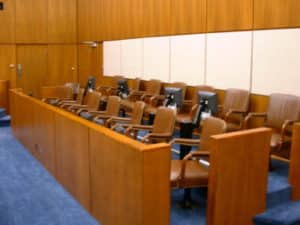Reaching a verdict
- After the Crown and defence make their cases, it is time for the judge and/or jury to reach a decision about the guilt of the accused
- Charge to the jury: judge reviews the law applying to the case, how certain evidence should be weighed, there needs to be intent etc.
Deliberation
- Jury leaves the courtroom to discuss and find innocence/guilt of the accused

- Determine the facts of the case (judge’s job is to determine the law)
- Can ask to see evidence again
- Throw out evidence that’s not believable
- Judge the importance of the remaining evidence
- Ex. Is the accused of 1st degree, 2nd degree murder OR manslaughter
- Hung jury: when a jury cannot reach a decision: the trial must be re-set and re-done
- Foreman (head juror) reads the verdict in court
- R v G (R.M.)
Sentencing
- Factors in sentencing: can include
- Criminal code
- Precedents
- Charter of Rights/Freedoms
- Accused’s criminal record
- Pre-trial custody
- Public opinion
- Victim impact statement
Steps in sentencing
- Pre sentence report: which describes the offender’s situation (lifestyle, prior convictions)
- Crown/defence lawyers may respond to sentencing and call witnesses, have the offender make a statement
Imposing a sentence
- Power of the judge: can determine the actual amount of months/years the sentence is to be
- Ex. Maximum 25 yrs: judge determines the actual length of time
- This is where the multiple factors come into effect – impact statements, will of Parliament: government’s stance on sentencing for certain crimes (length, time in jail/alternatives)
Goals of sentencing
- Deterrence:
- Sentencing should keep people from wanting to re-offend, and reflect the society’s lack of tolerance for breaking the law
- Specific deterrence: to not commit the specific crime again
- General deterrence: all citizens should not commit that specific crime
- Rehabilitation:
- The act of re socializing an offender back into society.
- Job training
- Counselling
- Supervised parole
- Reduce recidivism: returning to prison/committing new crimes
- Retribution:
- Not a sentencing objective
- Supreme Court: “an objective…that properly reflects the moral culpability of the offender…the intentional risk taking of the offender, the harm caused by the offender, and the character of the offender’s conduct
- Segregation:
- To keep offenders from society
- Currently, Canadian law is focusing on alternative methods to reduce the number of people in prison, though for serious crimes, prison is the only option
- Punishment has to fit the crime
- The most severe punishments are handed down to those who are most offensive to society
- Mitigating circumstances: lessen the responsibility of the offender
- Aggravating circumstances: increase the responsibility of the offender
Restorative Justice
- Restorative justice: focuses on healing relationships – the offender, victim, the community
- Used within the Aboriginal community
- Sentencing circles: brings all parties together to express their opinions and determine a sentence
- Healing circles: to resolve the conflict between victim and offender
- Releasing circles: community, parole board, offender meet to prepare a successful return to the community
